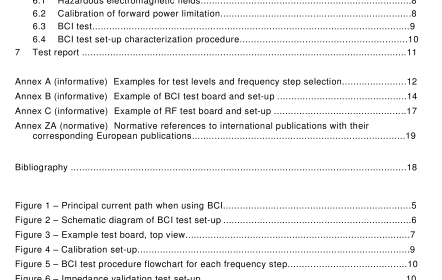BS EN 62132-3:2007 – Integrated circuits — Measurement of electromagnetic immunity, 150 kHz to 1 GHz — Part 3: Bulk current injection (BCI) method

Two electrically shielded magnetic probes are clamped on one wires or a combination of wires that is/are connected to the device under test. The first probe is for the injection of RF power that induces I disturbance onto the wires. The second probe is used for monitoring the i
nduced current on those wires. The disturbance current flows in a loop comprising: wire(s), the selected IC’s pin(s), V ss terminal, ground path and supportive circuitry. This supportive circuit provides the IC functional elements as source and/or load(s). The supportive circuitry is directly connected to the IC. When the equivalent RF impedance of the supportive circuitry is larger than 50 Ω, then a by-pass capacitor is recommended.
The by-pass capacitor, to be used at the supportive circuitry side, may also be needed to confine the loop area in which the induced current will be flowing. By default, the lumped by-pass capacitor of 1 nF shall be used. It represents the capacitance from the wire onto a cable harness or chassis. Deviation from using this bypass capacitor (e.g. as functional performance becomes affected) shall be given in the test report The by-pass capacitor may be supplemented with optional decoupling network, see Figure 3, to achieve the required attenuation towards the supportive circuitry. The decoupling impedance is determined by the RF immunity of the supportive circuitry. It shall not adversely affect the response of the device under test, i.e. the result of the test. The disturbance current I disturbance induced into the wire(s) flows through the IC and may create a failure in the device’s operation. This failure is defined by parameters called the immunity acceptance criteria, which are checked by a controlling and monitoring system.
5 Test conditions
5.1 General The general test conditions are described in the IEC 621 32-1 . During the immunity tests, either a continuous wave (CW) or an amplitude modulated (AM) RF signal shall be used as the disturbance signal.
The device under test (DUT) shall be exposed at each frequency for sufficient dwell time. By default, an amplitude modulated RF signal using 1 kHz sinusoidal signal with a modulation index of 80 % is recommended for testing. When an AM signal is used, the peak power shall be the same as for CW, see IEC 621 32-1 . When other modulation schemes are used, they shall be noted in the EMC IC test report.
BS EN 62132-3:2007 – Integrated circuits — Measurement of electromagnetic immunity, 150 kHz to 1 GHz — Part 3: Bulk current injection (BCI) method